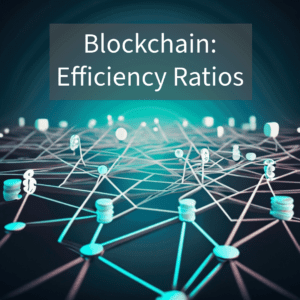Blockchain: Efficiency Ratios

Organizations continually seek ways to enhance their efficiency ratios – crucial performance indicators measuring the time it takes to generate cash or income. This pursuit has led to recognizing blockchain technology as a powerful catalyst for improving efficiency, decentralization, and transparency, revolutionizing how businesses operate.
Decentralization, a cornerstone of blockchain, plays a pivotal role in transforming efficiency ratios. By eliminating the need for intermediaries in data access, modification, and transfer and ensuring no single points of failure, blockchain significantly reduces obstacles and enhances performance across various ratios.
Return on Assets (ROA) and Return on Equity (ROE): Drastically reduces licensing fees, hardware costs, and maintenance costs by automating payment settlements, potentially saving businesses up to $200 billion annually in transaction costs alone. It also mitigates risks associated with data center outages, estimated to cost up to $100 billion annually.
Asset Turnover Ratio: Facilitates easier tracking of assets and transactions, enabling informed decision-making, and is associated with a 10% increase in ROA for every one-standard-deviation increase in asset turnover ratio.
Inventory Turnover Ratio: Enables real-time tracking of inventory levels, preventing stockouts and reducing waste. According to surveys from multiple organizations, organizations of all sizes experience a significant return on investment simply by avoiding inaccurate reporting and miscommunication.
Days Sales Outstanding (DSO): Accelerates payment cycles, improving cash flow and preventing losses of $260 billion annually attributed to slow transaction speeds.
Expense per Capita: Enhances visibility to identify expense reduction opportunities, reduces fraudulent claims, and improves compliance. Poor expense management costs businesses an average of $1.3 million annually.
Blockchain goes beyond decentralization, offering an array of benefits that enhance overall system efficiency, reduce obstacles, and require less training through automation.
Operating Cost: Automates manual data entry, eliminates paperwork, and relieves the burden of expense reports, saving businesses an average of $1.6 million annually.
Revenue per Capita: Provides real-time data and analysis for improved decision-making and customer service, preventing losses of $1.6 million annually attributed to poor customer service.
Tax Revenue as a Percentage of GDP: Prevents fraud, automates ticket issuing, and streamlines tax processes, contributing to the reduction of the estimated $114 billion to $441 billion annual losses due to tax evasion and fraud.
In conclusion, the application of blockchain in efficiency ratios has the potential to save and generate an unquantifiable amount of money and time in both the public and private sectors. By leveraging blockchain technology, organizations can unlock new operational efficiency, financial optimization, and resilience levels, paving the way for a transformative future in business operations. The challenge is now extended to businesses: What steps are you taking to integrate blockchain and reshape your efficiency strategy for a more prosperous future?
Reach out to see how we’ve helped other organizations integrate blockchain into their operations.
